Recent Viewing: April and May, part one
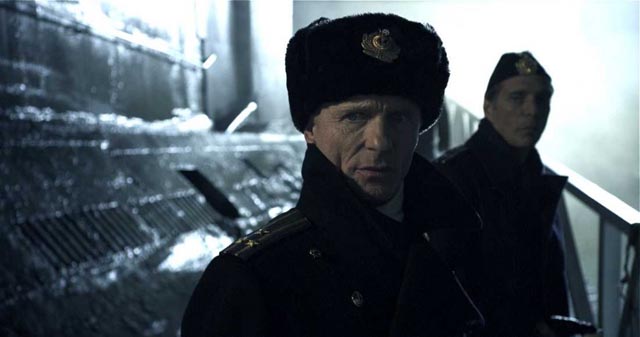
Once again, I’ve fallen way behind in commenting on the movies I’ve been watching. So here are some brief comments on recent titles, some of which deserve more attention (though I’m not sure I’ll be able to get around to that any time soon).
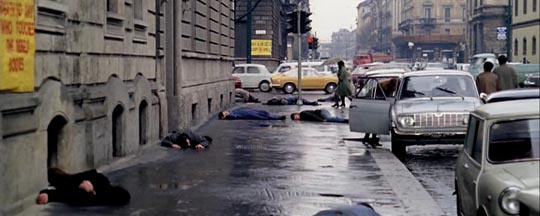
Italian director Liliana Cavani is still best-known for The Night Porter (1974), her transgressive story of the sado-masochistic bond between a former SS officer and a former concentration camp inmate. In 2002, she made a fine new version of Patricia Highsmith’s Ripley’s Game (previously adapted by Wim Wenders as The American Friend [1977]), with John Malkovich as the sociopathic anti-hero. Both of those films seem pretty mainstream when compared to her second feature, I cannibali (The Year of the Cannibals, 1970), a modern retelling of Sophocles’ play Antigone, about a daughter who defies an oppressive state in order to honour her dead brother with a proper burial. I cannibali is a late example of ’60s radical cinema, echoing the widespread political turmoil of ’67 and ’68 (in both Europe and North America), and obviously influenced to some degree by Godard. Its imagery of modern city streets littered with the unburied dead of a suppressed student uprising has some power, but the film feels as dated as some of Godard’s own more radical works, surviving (in a fine edition from Raro Video) very much as an artifact of its time. The disk has an interesting interview with Cavani (now 80) about the making of the film and the circumstances out of which it grew.
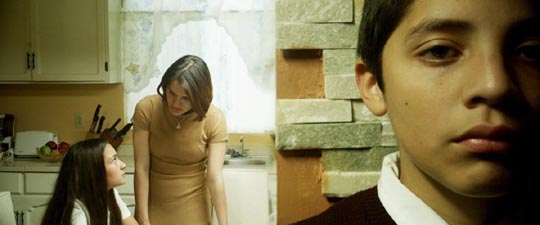
Here Comes the Devil (Ahi va el diablo, 2012) is a promising Mexican horror film directed by Spanish-born Adrian Garcia Bogliano. It begins with a family enjoying a day in the country; while mother and father retire to the car for a bit of sex, the two children climb a nearby hill which is apparently reputed to be haunted. The kids disappear, triggering a widespread search – and this stretch has something of the mysterious atmosphere of Peter Weir’s Picnic At Hanging Rock. When the kids suddenly reappear a day later, it seems that they’ve been changed somehow … and, indeed, they are actually changelings (the fate of the originals revealed late in the film). While the film has some creepy atmosphere, it falters because the two evil kids don’t actually do much; yes, they’re evil, but apart from coming across as moody adolescents, they don’t appear to pose much of a threat and the story can’t find anywhere to go other than repeating the kids’ fate with the parents for a rather pat downer ending.
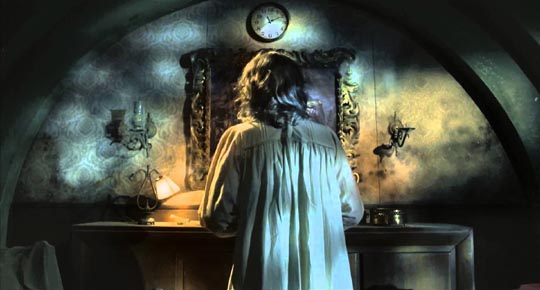
Much more interesting is The House Of the End Times (La casa del fin de los tiempos, 2013), a Venezuelan movie by first-time writer-director Alejandro Hidalgo. A woman returns to her old home after serving forty years for the apparent murder of her family and finds herself beset with strange, seemingly supernatural events which echo the original violence. What seems like a combination murder/ghost story evolves as something more complex and interesting: the house is at the centre of a warp in time, and the events represent the interconnections of a forty-year loop in which the woman exists at multiple ages, discovering the truth about what happened to her family and her own displaced part in the violence. Hidalgo manages to maintain the multiple levels, gradually revealing the truth, without losing any of the threads. The film is reminiscent of Nacho Vigalondo’s Timecrimes (2007) and is almost as good.
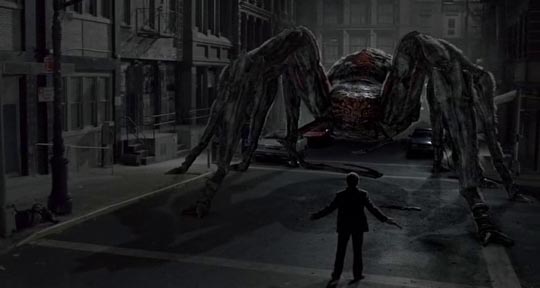
At the far end of the imaginative spectrum from Hidalgo’s film is Spiders (2013). Shot in 3D in Bulgaria, with Sofia standing in for New York City, this is the latest movie from the prolific Tibor Takacs. I was drawn to this largely because my friend Gord Wilding has production-designed three of Tibor’s low budget genre movies – two here in Winnipeg (Nostradamus [2000] and Tornado Warning [2002]), and one in Bulgaria (Killer Rats aka Rats [2003]) – so I feel an odd personal connection (I even spent some time hanging out on the set of Nostradamus). But my first memory of Tibor’s work was seeing his “Orwellian” Canadian TV feature The Tomorrow Man (aka 984: Prisoner of the Future [1982]) on late night TV three decades ago (it was pretty dull, but I’d watch anything with even a vague sci-fi connection). Spiders is a bigger, better shot at a bug movie after Tibor’s CG-impaired Ice Spiders (2007) – which also starred Patrick Muldoon, former bug-fighter Zander from Paul Verhoeven’s Starship Troopers. The concept of Spiders is ludicrous: Russian scientists mixed alien DNA with spiders’ DNA in an orbital lab in order to produce ultra-tough web silk which makes better body armour than Kevlar; when the satellite crashes to Earth it unleashes rapidly growing arachnids which the army tries to contain even as they attempt to perfect the new armour. (Military bad guy Colonel Jenkins is played by William Hope, who also has previous bug experience having played the incompetent Lt. Gorman in Aliens [1986]). Needless to say, hapless civilians are sacrificed by the evil spider-military complex. Spiders has a cheesy B-movie charm, and the CG is a definite improvement over Tibor’s previous spider opus. I probably would be less forgiving if it weren’t for the (very) tangential personal connection.
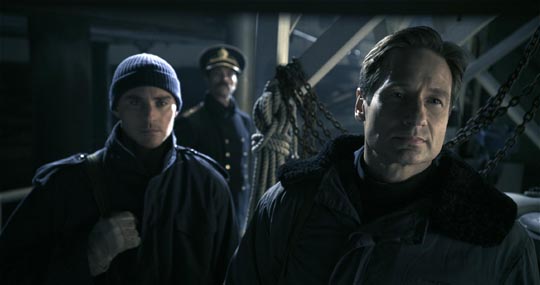
One thing I’ve noticed over the years is that movies which deal with things I’d absolutely not want to be involved with in real life have a definite appeal. Horror movies, disaster movies, war movies … stories which subject people to dangerous extremes, within which as a viewer I can position myself with the survivors. As someone who’s lived a fairly long and trauma-free life, perhaps there’s something a little hypocritical about this appeal; I’ve never sought out risks (for a while, back in the ’90s, I had several friends who suddenly developed a passion for sky-diving, but I felt no urge to join them). But I do enjoy vicarious danger. Which is why I have a long-standing affection for submarine movies – how much more concentrated can danger be than inside a crowded, claustrophobic vessel submerged in the ocean? Todd Robinson’s Phantom (2013) is an underrated gem, a bit of Cold War speculation set aboard a decrepit Soviet sub in which possibly renegade KGB agents take over in order to trigger a nuclear war between the U.S. and China in order to eliminate the USSR’s two rivals without (supposedly) harming the motherland. Robinson’s script is tight and efficient, with well-drawn characters, and his direction makes the most of using an actual decommissioned sub as the main set; it has the same grimy, gritty feel as Wolfgang Petersen’s masterpiece, Das Boot (1981). The cast, led by Ed Harris as the captain and David Duchovny as the fanatic, is excellent (and thankfully unencumbered with phony Russian accents, the one flaw in Kathryn Bigelow’s K19: The Widowmaker [2002], which actually shot for a day on frozen Lake Winnipeg, just North of here). Marred only by a brief sentimental coda, Phantom is a fine reiteration of Cold War thrillers like James B. Harris’s The Bedford Incident (1965).
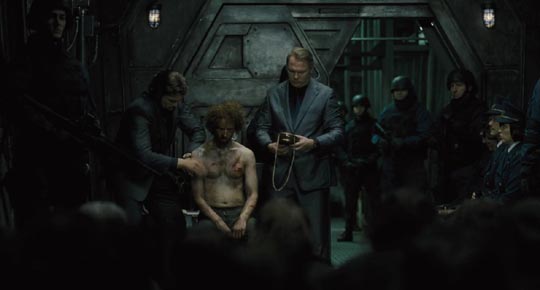
Snowpiercer (2013), the latest from Korea’s Bong Joon-Ho, is an ambitious sci-fi allegory based on a French graphic novel. In an attempt to avert global warming, a coalition of governments have inadvertently triggered a new ice age which has wiped out virtually all life on Earth. Thanks to visionary industrialist-scientist Wilford (Ed Harris again), a remnant of the human race has been preserved on a supertrain which circles the planet, drawing energy from the ice and snow it’s continually ploughing through. On board, there’s a rigid class structure, with the decadent rich partying away up front while the oppressed and exploited poor struggle to survive at the rear, kept in place by a vicious military run by sadistic bureaucrats. There have been periodic attempts at revolution and the film follows the latest, led by Curtis (Chris Evans), who has been nurtured and educated by the crippled Gilliam (John Hurt), Wilford’s former partner. As Curtis and his followers fight their way through the train – with a lot of bloody slaughter – it gradually becomes clear that these rebellions are manufactured by those at the top in order to maintain the stability of the train’s population. But of course, this time it’s different… Snowpiercer is visually impressive, with plenty of dynamic action and some interesting performances (particularly Tilda Swinton, who obviously had a great time playing the obnoxious bureaucrat Mason), but somehow never achieves anything larger than a kind of dogged iteration of the basic idea. The implications of the rigidly stratified class structure remain unexplored, merely suggested by brief glimpses as Curtis passes through the various cars on his way to the engine and a revelatory confrontation with Wilford.
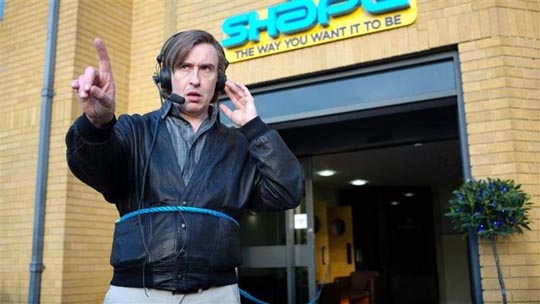
As a longtime fan of Steve Coogan’s insufferable media wannabe Alan Partridge (I have the original BBC radio shows on my iPod and have listened to them countless times over the years), I was curious to see how such a gratingly funny character could be transferred to the big screen. Turns out Declan Lowney’s Alpha Papa (2013) manages just fine. Alan is struggling to survive in the rapidly evolving corporate media landscape as the host of a show on a Norwich radio station. When the station is taken over by one of those homogenizing conglomerates, in a desperate attempt to hold onto his job, Alan betrays Pat Farrell (Colm Meaney), a fellow broadcaster. Having been fired, Pat turns up with a shotgun and takes the station hostage. Which gives Alan a great opportunity to exploit the situation as a possible stepping stone to a better job in the majors. Consistently funny, with Alan’s plans inevitably backfiring at every turn, the film captures both the richness of British humour-of-embarrassment and the underlying sense of desperation which drives it.
*
POSTSCRIPT:

A few weeks ago I wrote about my disappointment with Beneath, the fifth feature directed by Larry Fessenden, a filmmaker whose work I have liked and admired since first seeing Habit at the Bloor Cinema in Toronto fifteen years ago. His films are marked by creative intelligence and a finely tuned sense of what can be accomplished thematically within the horror genre (and on a limited budget). So what happened with Beneath?
Curiosity compelled me to take another look at the movie on the new Scream! Factory Blu-ray, which comes with fairly extensive extras. While the hour-long behind-the-scenes featurette shows just how complex the shoot was – almost entirely made out on the surface of the lake, with cast in a small boat and crew and camera (and crane) floating alongside on a large raft – the lively commentary by Fessenden and second unit director and sound designer Graham Reznick offers a case study in how best intentions can nevertheless lead to a dead end.
Fessenden had apparently pitched several projects to Chiller Films, a producer of horror for TV; although they turned down his proposals, they did offer him a script by Tony Daniel and Brian D. Smith, which he accepted with the proviso that certain changes be made (essentially cutting out backstory and flashbacks) to concentrate on the kids’ confrontation with fate in the form of the killer fish and their own personal weaknesses. Fessenden talks enthusiastically about themes and directorial decisions – visual choices, references to other movies, details of performance – and if you closed your eyes as you listened to the track, you might see a worthwhile movie in your head.
So what happened? Why is Beneath such a dud, despite all the thought and effort that went into it? There’s nothing inherently wrong with the basic idea, and the movie is well shot by Gordon Arkenberg, and yet it remains inert. Is this just a case of filmmakers being blind to the weaknesses of their script? The characters are irritating and constantly do counter-productively stupid things while the camera shows the audience that it ought to be easy for them to escape the danger. Fessenden and Reznick make a point of saying how far the boat was from shore, but the camera gives us no sense of that distance (it’s a similar problem to the one in Night of the Living Dead, where we see the characters not bothering to board up some of the windows and wonder why the hell they don’t – it was because the filmmakers knew that there was a twelve-foot drop on that side of the house, so no danger of the zombies getting in that way; but of course we don’t know that and the oversight hangs there as an annoying detail).
While Fessenden has thematic reasons for the self-destructive stupidity of the kids, for the viewer it remains nothing more than stupidity. It doesn’t matter to us what the conceptual reasons are because on a dramatic level it alienates the audience; we don’t care about the fate of this group even if the filmmakers apparently do. And the failure to establish for the audience what the filmmakers themselves felt about the project is what results in the failure of the film itself for the viewer.
Comments